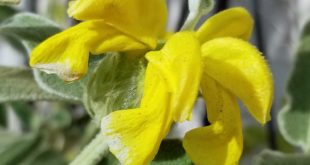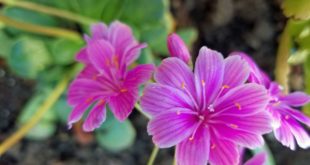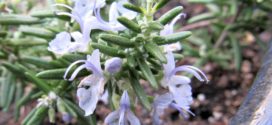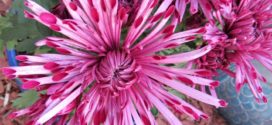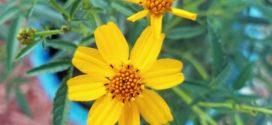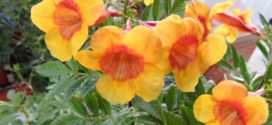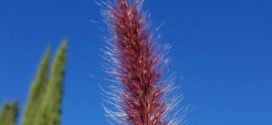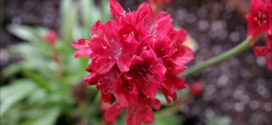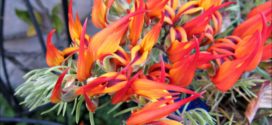New to our Sunnyvale garden in 2018, this Mediterranean native adds texture and summer color to the landscape with minimal care. Whorls of butter-yellow flowers contrast with woolly, silver-grey leaves on a dense shrub-like form. Plant this sun-loving, water-wise perennial as a border accent or mass on a sunny slope for a dramatic effect. Despite its name, it is actually …
Read More »Tag Archives: perennial
Lewisia Siskiyou
New to our Sunnyvale garden in 2019 is Lewisia cotyledon, commonly known as Siskiyou lewisia. Lewisia blooms from spring to mid-summer, producing large individual six-petal flowers in orange, pink, red, salmon, white or yellow that are held high above the foliage in a spray, lasting for several weeks. Lewisia is eye-catching in bloom, although, when grown from seed, it is …
Read More »Creeping Rosemary
Rosemary is one of those wonderful herbs that makes a beautiful ornamental plant as well as a welcome culinary seasoning to your Sunnyvale garden. Its Latin name, Rosmarinus officinalis , means “dew of the sea” and rosemary is most closely associated with the cooking of the Mediterranean area. However you don’t need perfect sunshine, sea mist or even a never …
Read More »Chrysanthemum ‘Pittsburg Purple’
Mums are always popular in the fall. Chrysanthemums were first cultivated in China as a flowering herb as far back as the 15th century BC.[9] Over 500 cultivars had been recorded by 1630.[7] The plant is renowned as one of the Four Gentlemen in Chinese and East Asian art. The plant is particularly significant during the Double Ninth Festival. Chrysanthemum …
Read More »Tagetes lemmonii ‘Compacta’
Tagetes lemmonii is new to our Sunnyvale garden in 2018. This herbaceous evergreen perennial in the sunflower family (Asteraceae) is native to Arizona and northern Mexico. The highly aromatic, fine textured medium green leaves are arranged on brittle stems. Electric yellow-orange daisy-like flowers provide intense fall color. Tagetes produces many small flower heads in a flat-topped array, each head with …
Read More »Tecoma ‘Sparky’
The Tecoma Sparky is a hybrid plant that was created in 2012 by Arizona State University. This plant was even named after the Arizona State Mascot “Sparky”. It is a variation of the Tecoma plant that is mainly a yellow flower with a red-orange center. Tecoma Sparky is found in the southern regions of the United States, mainly in Arizona, …
Read More »Red Fountain Grass
Red Fountain Grass dazzles with 10-inch bottlebrush plumes emerging burgundy-red in mid-to-late summer. Plumes shift a golden hue in fall and remain in place throughout winter. Flowing, ribbon-like grass blades adds texture and motion. ‘Red Head’ stands apart as one of the earliest-flowering fountain grasses. An excellent cut flower, fresh or dried. Plant in full sun and water sparingly to …
Read More »Acidanthera
Acidanthera is a summer-blooming bulb in the gladiolus family. The plants have upright, sword-like foliage and fragrant white flowers in late summer and early fall. Acidanthera is easy-to-grow in any sunny garden and it also grows well in containers. Known by many other names, including Gladiolus murielae, Gladiolus callianthus, Abyssinian gladiolus and peacock orchid. SHADE AND SUN: Acidanthera should be …
Read More »Armeria maritima
Another first in 2017 for our Sunnyvale garden: Sea pink. Armeria maritima, commonly called thrift or sea pink, is a compact, low-growing plant which forms a dense, mounded tuft of stiff, linear, grass-like, dark green leaves (to 4″ tall). Tufts will spread slowly to 8-12″ wide. Tiny, pink to white flowers bloom in mid spring in globular clusters (3/4-1″ wide) …
Read More »Lotus Berthelotti – ‘Red Embers’
The stunning, brightly colored unusually shaped blooms of the evergreen trailing plant Lotus berthelotii, commonly called parrot’s beak, brings a tropical feel to your garden or landscape. Native to the Canary and Cape Verde Islands off the west coast of Africa, Parrot’s beak is a sun-loving perennial that can be grown as an annual in areas below U.S. Department of …
Read More »